Motorola Moto G Review
by Brian Klug on December 18, 2013 2:00 PM EST- Posted in
- Smartphones
- Motorola
- Mobile
- *VA
- Cortex A7
- snapdragon 400
- Moto G
Cellular
The cellular side of the Moto G is an interesting one, at least for those who have kept constantly abreast of wireless banding configurations and the state of mobile RF. At the high end, pentaband WCDMA is now essentially ubiquitous, with parity LTE banding (given the shared nature of ports on the transceiver) and at least a handful more bands for whatever’s appropriate to the region. There’s no global LTE band combination equivalent to quad band GSM or pentaband WCDMA that has emerged quite yet, but it’s getting there, and in the next generation or two we’ll undoubtedly finally see it come to fruition.
|
Moto G (US GSM) |
Moto G (Global GSM) |
Moto G (CDMA) |
|
| Baseband | MSM8x26 - (Up to HSDPA 21.1 Enabled, EVDO Rev.A for CDMA) | ||
| Transceiver | WTR2605/WFR2600 (?) | ||
| GSM | 850/900/1800/1900 MHz | - | |
| CDMA2000 | BC: 0/1/10 | - | 850, 1900 MHz |
| WCDMA |
850, 1700/2100 (AWS), 1900 MHz (Bands 2, 4, 5) |
850, 900, 1900, 2100 MHz (Bands 1,2,5,8) |
- |
| LTE | - | - | - |
The Moto G however comes in a number of different flavors with different band combinations – there’s US GSM, Global GSM, and CDMA. I also suspect there’s at least one more dual SIM variant that we haven’t seen crop up just yet (Update: Apparently this exists already, XT1033 is the dual SIM variant, thanks @evefavretto). On the back case of Moto G there’s a space whose shape matches the microSIM tray at top, and on the board there’s a shield covering pads that are undoubtedly for a microSIM. Interestingly enough Motorola sampled me the Global GSM variant of the Moto G which lacks Band 4. I’ve been using it on T-Mobile successfully however thanks to the relative ubiquity of the 1900 MHz WCDMA carrier in my market. The US GSM variant of the Moto G trades Band 4 for 1 and 8 (2100 and 900 MHz), two popular bands internationally. I’ve seen Moto G erroneously listed as being a pentaband WCDMA phone, which it unfortunately isn’t.
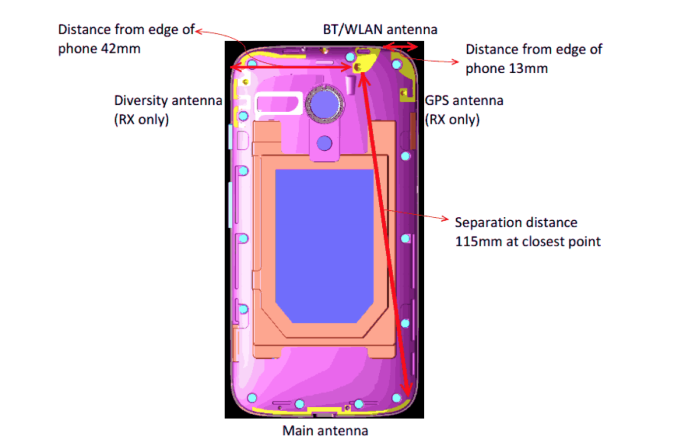
Primary Rx/Tx at bottom, Diversity Rx up top, WLAN/BT, GNSS Rx
Moto G does offer a leg up with receive diversity for CDMA1x/EVDO and HSPA+, something that some HSPA+ flagships from this generation amazingly enough still don’t include. The transceiver is WTR2605 for the primary Rx and Tx ports, and WFR2600 for the additional Rx diversity path. I have no idea what the port configurations look like for WTR2605, but I’d imagine it looks like a cut down WTR1605 of some kind. I have a suspicion that WTR2605 was designed for a quad band UMTS configuration with Bands 1,2,5, and 8, so it might indeed already be port limited in the Global GSM Moto G variant. I also wouldn’t be surprised if there’s some ready made front end module at the front of the whole thing.
Moto G arrives without LTE and instead offers up to single carrier HSPA+ with 64QAM, for up to 21 Mbps on the downlink. Although MSM8x26 itself has a modem block capable of up to dual carrier HSPA+ and category 4 LTE, it seems as though Motorola went for single carrier HSPA+ in the Moto G for time to market reasons, with the LTE and dual-carrier HSPA+ enabled software tree likely slotting in a quarter later than the initial code drop with single carrier HSPA+.
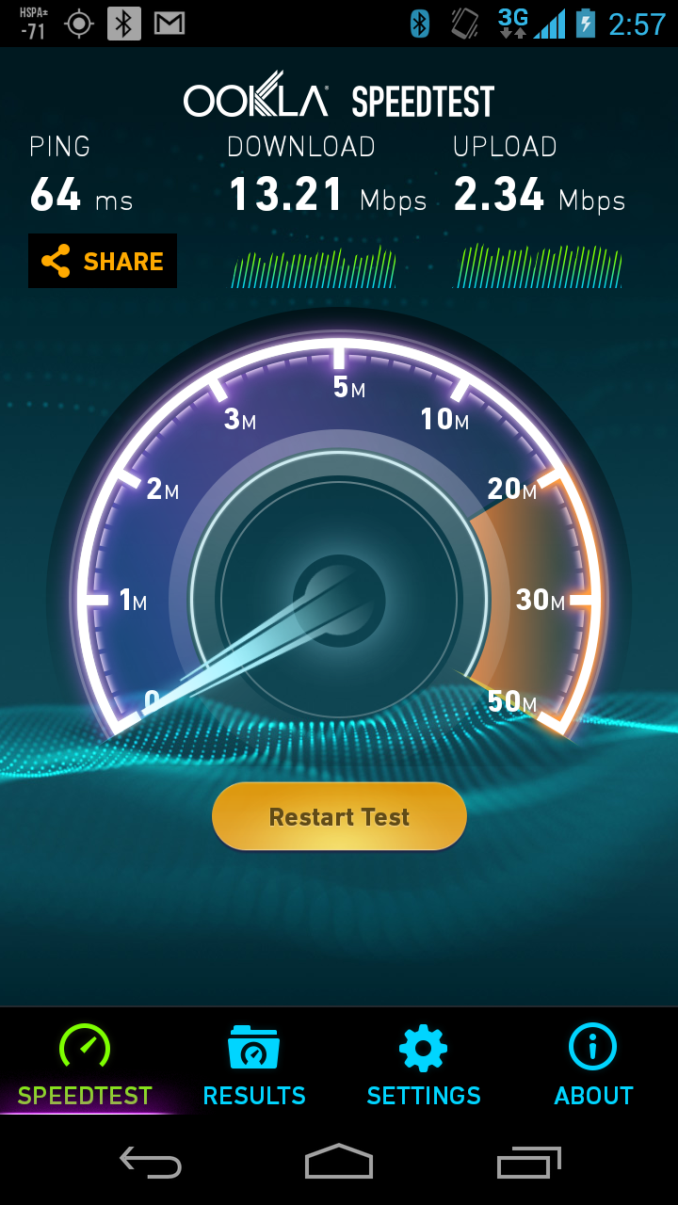
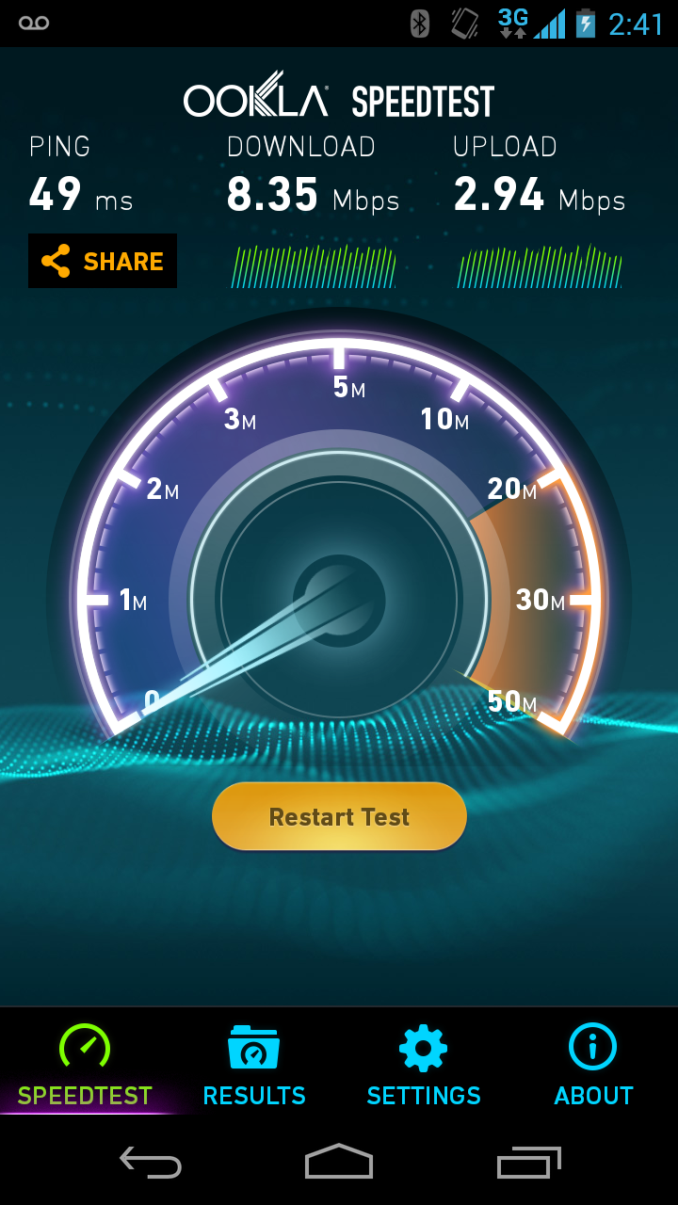
Not bad for single carrier HSPA+ on T-Mobile USA
I’ve been pretty pleased with the cellular performance of the Moto G, even using the variant that lacks Band 4 on T-Mobile USA. Not having LTE made me initially skeptical of it getting operator traction in the US, but it seems as though Motorola has actually had success at least on some prepaid tiers. I’ve been spoiled with LTE devices for a long time now, but single carrier HSPA+ is absolutely still survivable.
WLAN
WiFi connectivity on Moto G is single band 2.4 GHz 802.11n with BT 4.0 and FM receive. On the Moto G, that connectivity is courtesy the new WCN3620 BT/FM/WLAN RF combo chip in a wafer scale package. We’ve now seen WCN3660, the initial dual band combo, then WCN3680 which added 802.11ac, and now WCN3620, the cost reduced version which is single band 802.11n and no doubt offered at a competitive price point with the rest of the platform.
The WLAN/BT stack doesn’t do any antenna sharing and instead has its own transmit and receive path on the top of the Moto G. I don’t have any complaints about WLAN range on the Moto G.
To evaluate performance we turn to the same iPerf test same as always. I was able to attach the Moto G to my network at the 65 Mbps PHY rate that corresponds to long guard interval with a 20 MHz channel.
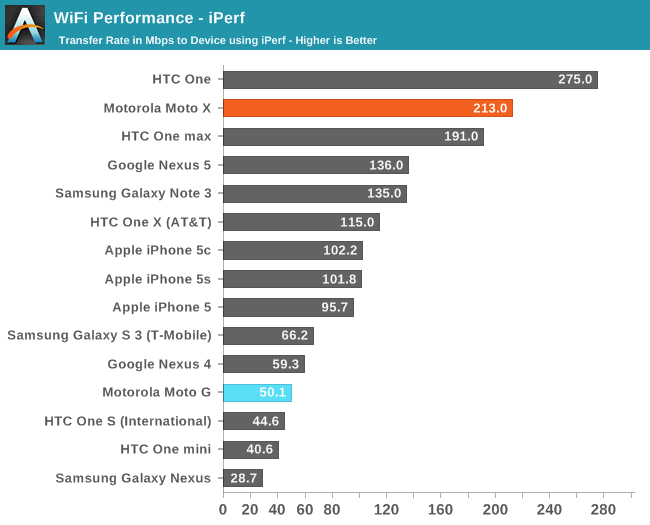
Performance is pretty decent at just over 50 Mbps. It’s a significant delta over the latest devices with dual band 80 MHz 802.11ac support, but again, totally solid relative to the tier it’s in.
Speakerphone and Noise Canceling
Speakerphone on the Moto G seems to be a big chamber if you take the back off, but there’s a relatively small seal against the whole affair, although the grille has larger holes than Moto X’s relatively tiny ones. Loudness is competitive, but unsurprisingly short of Moto X.
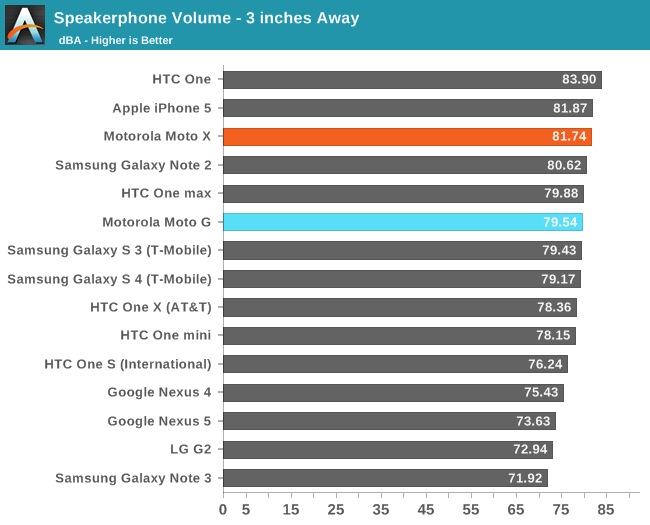
I’d describe Moto G’s speaker as decent, not overly loud or rich sounding.
Dual microphone noise suppression is still a somewhat notable feature at the midrange. In the case of Moto G, Qualcomm’s Fluence package is used in a configuration with the primary microphone at bottom and secondary at very top. I did some digging and also found that Moto G is using Qualcomm’s WCD9302 audio codec which we haven’t seen before, again a more midrange variant. I’ll leave the earphone/line out audio testing for Chris to evaluate.
Noise suppression on the Moto G is decent, but seems to have longer adaptation time than the Moto X. Using the exact same setup, I definitely noticed better rejection on Moto X as well, with less noise being passed through at the same volume level. I should also note that the Moto G does not appear to be AMR-WB enabled on T-Mobile.
GNSS
GNSS onboard the Moto G is the same Gen 8B as we’ve seen on 8974, which translates to support for GPS (USA “Navstar”), GLONASS (Russia), and Beidou (China), although the spec table for Moto G only lists GPS and GLONASS, leading me to believe Beidou might be reserved for devices destined for China. There’s a discrete antenna for GNSS on the Moto G, and I had no issues with getting fast, accurate 3D fixes. I remain impressed with Qualcomm’s GNSS which obviously benefits from integration right into the SoC.










120 Comments
View All Comments
makken - Wednesday, December 18, 2013 - link
" LG was arguably first to lay claim to it with its Optimus G, G Pro, G2, and now G Flex brands"Are we not counting the HTC G1 and G2 now? :(
blanarahul - Wednesday, December 18, 2013 - link
Htc is almost dead. I hope Lg buys them. That will give Samsung a run for their money.blanarahul - Wednesday, December 18, 2013 - link
Great review though. Although buying Moto in my country is just as good as buying a Chinese cellphone. There just aren't service centers around here.Flunk - Wednesday, December 18, 2013 - link
The do have service centers for other brands? You're a lucky guy, we need to ship our phones back to god knows where for service. My buddy's Samsung phone ended up in Korea for service.blanarahul - Wednesday, December 18, 2013 - link
I have only used Nokia, Sony and Samsung customer service. But I believe LG has good customer service too. I live in India. Sending to Korea would be a big pain in the ass.spencersears - Friday, October 3, 2014 - link
Motorola Moto G is a fantastic phone, I'd say only HTC One M8 could match up to it (see http://www.consumertop.com/best-phone-guide/). I don't think you'll need much of a service center though (I've not heard anyone who's had trouble with it), but the choice is yours.puremind - Thursday, December 19, 2013 - link
HTC has no reason to be dead any time soon. Like Apple, they will increasingly have to Focus on the premium market Segment (though for different reasons). HTC's supplier Rating and lack of Advertising Budget is the only reason they cannot compete well with Samsung, LG and Sony for the lower and mid range, but they will continue to produce superb devices for the top tier consumer segment.Nagorak - Tuesday, December 24, 2013 - link
They just reported their first loss ever. If they don't turn things around and keep losing money then that is the reason they'll be dead. Companies don't exist to lose money.BallGum - Saturday, December 28, 2013 - link
Yeah, it's quite a shame this is happening. The HTC One is a brilliant phone but despite everything they're just losing sales to Samsung. It's startling how they slipped from being where Samsung is now, but them consider Nokia...jasonelmore - Thursday, January 2, 2014 - link
It doesn't make financial sense to buy them unless they have tons of patents which are valuable to LG,